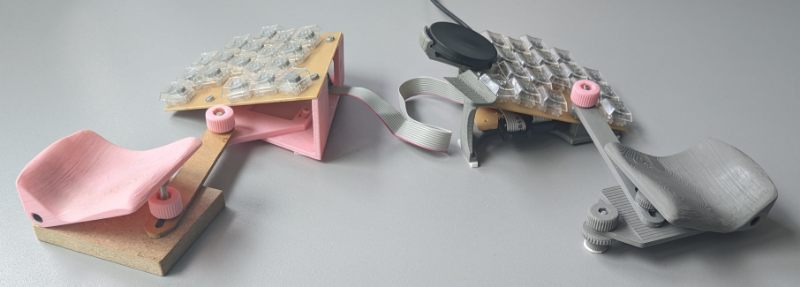These pages are about sharing my experience with ergonomic keyboards of more than two decades — building, using and refining them.
They are not about colors, neither switch types nor keycap colors, desk mats/pads or how things look like. My keyboards are not meant to look nice (whatever that is), but I am sure that they feel better and are usable in a greater range of different (seating) positions than most others presented on the internet.
I’ll show some uncommon (at least at the time of my publication) or unique approaches.
The pages are mostly structured chronologically, which means that in order to understand the reasoning you have to read everything top to bottom, page after page…this page, however, is about giving a shorter overview and some links instead.
1. Keyboards I actually use
Two slightly different ones for use at a proper desk:

3: a highly portable one:
4: a keyboard which is not as portable, but more comfortable and versatile.
2. What and why?
2.1. Physical layout of keys
-
Your hands are symmetric, but the traditional staggered keyboard is not — which is why it can’t be a perfect fit for both the left and right hand. You want to limit finger travel as well, so you go with an ortholinear keyboard.
-
Rotate both halves of the keyboard so that the key columns, fingers and elbows are on a straight line.
-
Don’t use a rectangular grid, because your fingers have different lengths and should comfortably rest on their home keys. This results in a "column staggered" layout.
-
Your thumbs can do more than hitting that single big space bar. Provide some keys they can easily reach and press.
-
Rotate the keyboard so that your hands are not facing downwards and your forearms are not twisted. People say this is ergonomic and it feels like that. But don’t go all the way up — been there, done that — it is just too much. Only stick to a flat one instead of "tenting" if you really need a portable keyboard.
-
For me, a second (outer) column was too much for my (obviously weak) pinky, which was one of the major reasons why I left my first line of keyboards behind.
2.2. Even more physical layout
-
Separate both keyboard halves if the keyboard is used at a desk only. Your keyboards should go where your hands are, not the other way around.
-
Use rests for palm and/or wrist and attach them to your keyboards. Advantage with split keyboard: "…to let my hands come back to a relaxed position faster after having moved them [the rests] or the keyboard away." Attached rests make the thing usable in a wider range of situations, see here. Even the small portable one has some.
-
Take care of other angles and keycap heights if you want to — but they don’t matter much.
2.3. Keymap, software
When learning something fundamentally new anyway you should leave QWERTZ/QWERTY/whatever behind and use something that was optimized for the task at hand. Maybe I would adapt neo2 today, but in 2001 the best I found was de-ergo and got used to it.
You need a bigger number of modifiers (which is what I did) or other tricks to compensate for the smaller number of keys. This was easy on my first line of keyboards, but they had 42 instead of 36 keys and didn’t even provide a windows or super key (which was fine for twenty years of usage anyway!).
With my second line of keyboards I’m using ideas by Manna Harbour which includes home row mods (other links: 1, 2, 3). Home row mods may sound like a blocker to you, but are really nice after getting used to — which I managed despite being 44 years old at that time.
2.4. Other notable properties
2.4.1. modular
My keyboards are quite modular, because I don’t want to build everything from scratch again when trying out something different:
PCBs for left and right half are connected to a controller board by a ribbon cable. Up to now there are three controller boards (arduino pro micro, FeatherBLE, nice!nano) and two keyboard PCBs (cherry mx and kailh choc). The 3d printed base of the desktop and versatile keyboard can be used with any controller (left and/or right) and keyboard PCB.
All my 36-keys keyboards (except the two flat portable ones) are using the same PCBs.
2.4.2. rectangular
The portable ones have a rectangular base and are wider than the keyboard itself. The common layout is smaller and may look fancy, but is hardly usable on your lap (bus, train, on top of laptop, somewhere without desk).
The rectangular base allows to just put something below the front or rear edge to tilt the keyboard.
2.4.3. adjustable
Allow for angles to be adjustable:
-
when using on a desk which is too high (see here)
-
when using the comfy non-desktop-version in different distances from your body
2.4.4. touchpad
Include a touchpad which is usable without lifting the hand from the rest.
2.4.5. smartphone mount
Include smartphone stands/holders (every current keyboard except the desktop ones). Sometimes I use them to type into my smartphone by bluetooth.